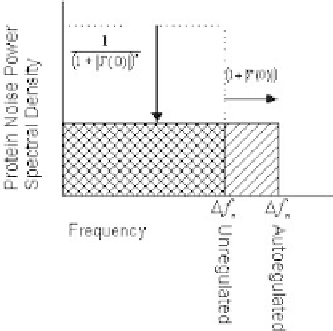Information Technology Reference
In-Depth Information
Figure 5.9
Graphical representation of the change in the protein noise power spectral
density (PSD) caused by feedback. The magnitude of the PSD is reduced by a factor
of 1
/(
1
+|
T(
0
)
|
)
2
, but the bandwidth is increased by a factor of 1
+|
T(
0
)
|
. The net
effect is a reduction of the noise strength by a factor of 1
/(
1
+|
T(
0
)
|
)
.
Perhaps analysis tools like those presented above are best used to examine
gene circuit structure-function relationships. These relationships may elucidate
the selective pressures that influenced natural genetic circuit topology, or in
synthetic biology applications, provide guidance in the selection of operational
regimes to explore either through simulation or experiment. The frequency
domain approach demonstrates the central role of loop transmission in noise
behavior, the shifting of noise to higher frequency regimes through autoregula-
tion, the trade-off between noise reduction through negative autoregulation and
excessive high frequency noise as phase margin is diminished, and the noise
optimizing ordering of parameters that control dynamics. This understanding of
simpler components allows an examination of the structure-function relation-
ship at higher levels of gene circuit ordering. Autoregulated gene circuits, like
those used in the example above, almost certainly play an important role in gene
networks [106], and the history of the development of feedback configurations
for electronic systems may be a resource for developing an understanding of
gene circuits and the selective pressure that drove their evolution. The extent
to which this analogy is useful can only be determined by a great deal more
analysis, modeling, and experimentation. Conversely, it is possible that new
strategies for engineered system design may emerge from this examination.
Certainly the development of electronic feedback amplifiers in the 1920s may
have benefited from an understanding of autoregulated gene function, and it is
possible that currently unidentified gene network topologies may impact future
system design strategies.

